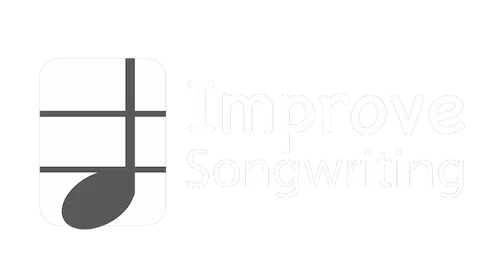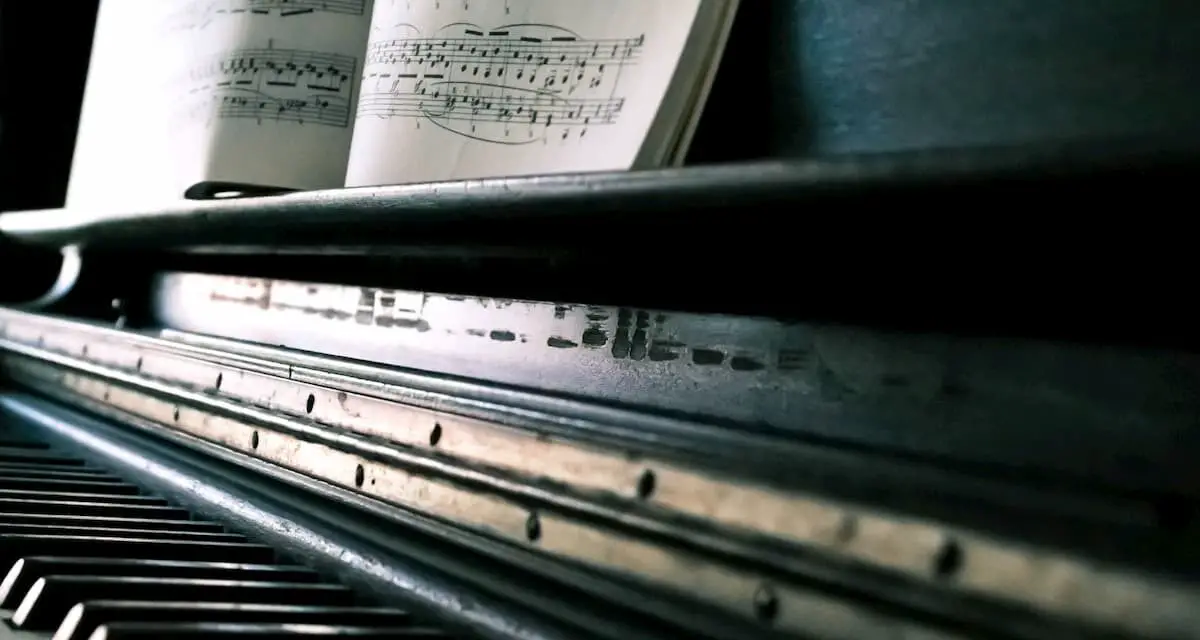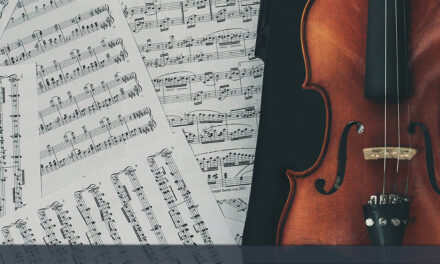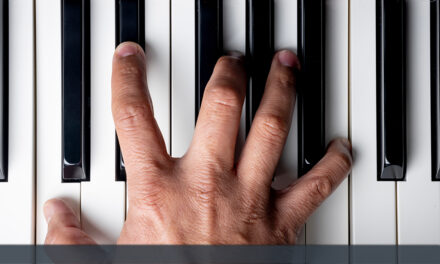Changing keys in music is an amazing effect that adds energy, contrast, and interest into your songs.
Come on, give it a try… all the cool kids are doing it!
If you’re interested in learning how to change keys in music, but you’re still not quite sure how this whole “key” thing works, don’t worry! I’m going to break it all down for you.
By the end of this post, you’ll understand what it means to change a key and how to pick the right one for your song. Plus, as a nice bonus, you’ll walk away with 5 techniques for executing a key change when you’re writing your own music!
Ready? Let’s do it!
What Does Changing Keys in Music Mean?
When I was a sophomore in college, I was just starting to get into playing guitar and writing my own music. But I wasn’t a music major and I had no foundation in the academic side of music, so I would occasionally ask my music student friend Brian some questions.
One time, I asked him to explain the concept of a key… Like, what does it even mean to be in a key? If I play a C major chord, why does that mean I’m in the key of C major – and not in A minor, or G, or F?
As a gifted musician, Brian intuitively knew what a key was, but he didn’t know how to explain it to me.
And ironically, I think THAT fact is actually the perfect way of describing how most average music listeners relate to a “key” in music: they know what sounds right and what doesn’t, but they can’t quite explain why!
Improve your songwriting by mastering piano.
$49
ONLY
Introducing the Tonal Center
So, what is a key? Music has the answer!
Think of a musical key as a group of pitches all relating to a “tonal center,” which is like the sun in the center of the solar system that the different planets revolve around.
When you listen to a song, your ear automatically picks up on the tonal center – and every other note you hear is in relation to the tonal center within the key.
That’s why people with no musical training can hear cadences and predict when a chord is about to resolve to the I chord (ie the tonic). It just sounds “right.”
How Can You Switch Keys in a Song?
So, when you change keys – a concept also known as “modulation,” if you want to be fancy about it – you’re being a rebel. You’re bending the rules and coloring outside the lines. You’re saying “No!” to conformity (just like EVERY other songwriter who changes keys right before the final chorus…)
Ahem.
In practice, changing keys jolts the listener and forces them to pay attention, because this is uncharted territory, outside of the pre-established boundaries that were already set for the song. If you suddenly start using notes or chords outside of the key, you’re calling a LOT of attention to the effect!
This can be good or bad, but I’m not here to judge – I just want to help you modulate like a pro!
So, here are 5 techniques for changing keys effectively, along with some specific examples for when to use them, so you can put them into practice for your OWN songs!
1) Switch to the Relative Major or Minor Key
Let’s start with an easy one.
I guarantee you’ve done this before without even thinking twice about it! Every major key has a closely related key called the relative minor – they’re kind of like cousins or siblings.
The magic thing about them is, any relative major and minor key both contain ALL of the same seven notes and chords.
For example, the key of G Major has the following notes:
G A B C D E F#
And its relative minor key of E minor? That one contains the following notes:
E F# G A B C D
Notice, they both consist of the EXACT same notes, just shuffled around a little! In the case of E minor, it simply starts on the note E instead of G. (You can find the relative minor at the 6th degree of the major key, or count down three semitones from the tonic. For the relative major, locate the 3rd scale degree in the minor key.)
This gets back to what I was saying before about the tonal center – it’s the tonic note or chord that all other notes and chords in the key sound in relation to.
To easily switch from one key to its relative major or minor key, all you really need is a shared chord – called a pivot chord – that transitions between them smoothly. In the example above, Em or G major would be effective pivot chords since they sound so similar and are shared by both the key of G and the key of Em.
2) Switch to the Parallel Major or Minor Key
Another common way to change keys is going from a major key to its parallel minor (or vice versa).
Don’t get this confused with the relative key change I just talked about – a parallel key features the same tonic, but the major or minor version of it. For example, the parallel minor of C major would be C minor (by comparison, the relative minor of C major is A minor).
C major and C minor are closely related keys, kind of like two twins where one is usually happy and the other is just a LITTLE emo…
But even though it DOES sound different when you change to a parallel key in a song, it’s still pretty familiar to the listener. This type of modulation is more subtle and gentle compared to other key changes.
One of the easiest ways to make the switch between parallel keys is to use the dominant (V) chord as a pivot chord. Instead of resolving to the I chord in a major key, you end up on the i chord in the parallel key.
For example, in the key of C major, you could use the V chord (a G major).
(Technically, the dominant (v) chord in the natural minor key is also minor, but you can always get away with the major V chord if you borrow it from the harmonic minor scale.)
You could also get away with using a V7 chord – that has the strongest pull back to the tonic, whether it’s major or minor!
3) Jump a Half Step
Instead of modulating to the closely related relative or parallel keys, you can also just move the whole song up in pitch.
This effect often lasts for the remainder of a song. You’ve heard this in countless pop songs, as well as other genres like marches, classical, and jazz music. The colloquial name for this effect is the Truck Driver’s Modulation. Think of it like a driver suddenly shifting gears.
The half step is the most common interval for a direct key change like this. It’s not a crazy distance, but it’s still big enough that listeners will take notice!
An example of a half step jump is moving from the key of Eb major to the key of E major, or from the key of B major to the key of C major.
Why jump a half step? In previous examples, we talked about using a pivot chord to smooth out a modulation – but you don’t ALWAYS need a smooth chord transition to go from one key to another. Sometimes, you just sorta take the leap.
Done right, it’ll sound great and add an uplifting energy to the song in its final stretch. (But if done wrong, the effect is SUPER cheesy…)
There are countless examples of songs that change keys like this – often, you’ll hear a few notes of the melody in the new key before the accompaniment comes in as well.
In effect, nothing changes except for the change in keys. All of the chords and the melody notes stay the same in relation to each other – but they end up a half step higher than before.
4) Jump a Whole Step
Continuing with the idea of the Truck Driver’s Modulation, it’s also possible to jump a whole step.
Commonly, when you modulate a whole step, it works well to start with the V chord in the original key, because this happens to be the same as the IV chord in the new key (a whole step above).
For example, in the key of C major, the V chord is G major – but G major is also the IV chord in the key of D major! You can see why G major is also a great choice of pivot chord, if you want to make a smoother change from the original key to the new key.
5) Use a Chromatic Mediant
If you want to move even farther away from the key you started in, you’ll need a more advanced understanding of music theory – or the courage to just experiment and figure out what sounds good. That works too!
But if you want a structured way to move up more than a whole step, consider using a chromatic mediant.
Real quick, remember that diatonic refers to the chords within a key, and chromatic refers to chords that lie outside of the key.
Also, mediant refers to the third scale degree.
Putting all of that together, a chromatic mediant is a chord that’s a third away from the chord you started at, falling outside of the current key.
To do a key change with a chromatic mediant chord change, let’s look at an example. If you’re in the key of E, you can move to the key of G. A chromatic mediant needs one common tone, as well as a chromatically altered tone.
E major chord – E G# B
G major chord – G B D
In this case, you see that B is a common tone in both chords, and G is a chromatically altered tone down one half step from G#. The other tone is not shared.
When you make the leap from an E major chord to a G major chord, you have the power to choose whether the new key is G major, or whether you’re using G as the dominant and you’re actually in the key of C major.
Changing keys with the chromatic mediant may take a little more careful planning to pull off, but it can work well – and because many artists don’t use it, your song can stand out with this technique.
When to Implement a Key Change?
We’ve looked at 5 excellent ways to implement key changes in your music, but there’s one more important question to answer before you start using them: where in a song should the key change happen?
First of all, you’re in charge of your own music. It’s true that music theory teaches us some “rules” to remember, but making music should be more organic than that… So, follow your heart or whatever.
With that said, here are some of the times when modulation is most effective:
- A key change between sections. Many, many songs have a verse in one key and a chorus in a different one. Or a verse changing into a pre-chorus. Or the end of the chorus moving into a pre-chorus. In terms of song structure, this is because the tone is often supposed to be different, and a different key helps you create more contrast – but you can get usually away with closely related keys here, like the relative or parallel major/minor.
- A key change for your bridge/middle 8. Speaking of different sections, if there’s ONE spot where a key change makes the most sense in a typical song, it’s your bridge! This section is thematically unique, and serves as a “bridge” between where the song has been and where it’s going. A different key helps communicate that something new is happening.
- A key change right before the last section of the song. The Truck Driver’s Modulation is that famous effect where you do one or more key changes in the final chorus/outro of a song. “I Will Always Love You” by Whitney Houston is a classic and powerful example of this effect.
- A key change temporarily within sections. In your chord progressions, it’s possible to implement a quick key change through what are known as “borrowed chords.” Basically, if you briefly use a chord that’s not part of the key and then go back to the original key, you’ve modulated temporarily, creating interest without fundamentally changing the tone of the song. You can hear an example of this in the main chord progression for “Creep” by Radiohead.
Again, these aren’t hard-and-fast rules, and they can vary by genre. But it’s a good way to think about modulation if you’re interesting in adding this amazing effect to your next song!
How Do I Change Keys Smoothly?
One more note about changing keys: you get to decide whether the change is subtle… or DIRECT!
For subtlety, it’s sometimes possible to do a key change almost like a sleight of hand!
By using a common pivot chord between two closely related keys, the effect is a magic trick where the listener doesn’t quite know what just happened, but it works and it sounds great!
Other times, it’s more like you’ve slapped up a flashing neon sign saying, “KEY CHANGE!” The listener couldn’t miss it if they tried, and you don’t want them to. When you’re about to wrap things up, a final key change usually coincides with the climax of a song.
How far you modulate will also affect whether it seems smooth or abrupt. Closely related keys won’t be as obvious, but jumping a major third to a chord in a new key will stick out like crazy. It just depends on what works best for your song!
Changing Keys in Music Wrap-up
Well, I hope this guide helped you understand modulation better and learn more about changing keys. If you feel like your songs always sound the same throughout or never display a change in intensity or energy, just switching keys between (or within) sections is a simple way to add contrast and really spice things up!
But if you’ll allow me to use a cooking metaphor, modulation is very much a spice, not the main dish. I recommend you move between keys only when it makes sense to do it – otherwise, your song may sound aimless or end up lacking that all-important tonal center.
Ultimately, it’s not just about picking the key. Music is also about chord progressions, melody, dynamics, instrumentation, production, effects, and so many other things!
To learn more about all of these closely related (dare I say… key!) facets of songwriting and music production, please check out other posts right here on Improve Songwriting! I’m sharing as much as I can to help you be the songwriter you’ve always wanted to be.
Do you want to get more comfortable playing songs in all different keys? I believe the best way is by knowing the piano. Level up your songwriting and music theory at the same time with Piano for All!
Improve your songwriting by mastering piano.
$49
ONLY













